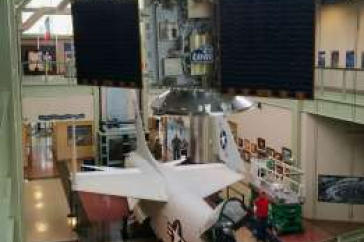McAuliffe-Shepard Aerospacefest to Feature UNH-Built Satellite

The UNH Cooperative Astrophysics and Technology SATellite (CATSAT) "flies high" above a vintage 1956 Crusader jet, like those flown by Alan Shepard as a test pilot, at a new exhibit at the McAuliffe-Shepard Discovery Center in Concord, N.H.
DURHAM, N.H. -- This year's Aerospacefest at the McAuliffe-Shepard Discovery Center Saturday, June 13, 2015, will feature a new exhibit of a small satellite built in the late 1990s at the University of New Hampshire's Space Science Center (SSC) by faculty, staff, and students. It represents one of just a few satellites ever built entirely by a university and is the first and only complete satellite designed and constructed in the Granite State.
The Cooperative Astrophysics and Technology SATellite, or CATSAT, was developed to discover more about the sources of the mysterious, dangerous and most energetic segment of the electromagnetic spectrum—gamma rays, and ultimately helped launch many UNH students into high-profile aerospace industry careers.
Aerospacefest will be held from 10:30 a.m. to 4 p.m. at the Discovery Center in Concord. The keynote speaker will be NASA astronaut and UNH alumnus Rick Linnehan. At noon, select members of the CATSAT team will give an historical overview of the satellite project and insight into the science of gamma-ray detection. A touch-screen computer display will provide a guided tour of the satellite components, student interviews, and more.
"We are delighted to have this impressive piece of New Hampshire history and technology on display in its new place of honor in the Discovery Center's central atrium," says Jeanne Gerulskis, executive director of the Discovery Center. "UNH's CATSAT satellite will be viewed by tens of thousands of young people and their families each year and we hope it will help inspire students to enter careers in science and engineering. We are very excited to host members of the CATSAT team at Aerospacefest."
CATSAT was the result of a 1994 NASA program known as the Student Explorer Demonstration Initiative, or STEDI, that tasked U.S. colleges and universities with developing small, rapidly built low-cost space missions that could accomplish significant research and/or develop new technologies for Earth and space exploration as well as provide students with extensive, hands-on experience.
Ultimately, UNH was one of only three universities selected from a field of 66 STEDI satellite design and construction projects. UNH space scientists have built satellite instrumentation since the dawn of the space age, and today the SSC is regarded as one of the top three such centers in the nation.
Says Mark Granoff, SSC senior project engineer who, along with key CATSAT colleagues led the effort to "fly" the satellite at the Discovery Center, "CATSAT students, faculty and staff at UNH and its CATSAT partner, the University of Leicester in the United Kingdom, tackled complex engineering and physics problems utilizing UNH's long, proud history of building complex science instruments for NASA missions. The result was a satellite that was completed in 2002 with students being involved in the design of every aspect of the system—far more involvement than any other STEDI mission."
Although CATSAT met all of NASA's requirements and was ready for launch, the 325-pound satellite never made it into space due to a shortage of launch vehicles. But as Granoff stresses, the little satellite did propel a large number of UNH students into successful aerospace careers, which was central to the STEDI mission.
Among those students is Willard "Bill" Simmons, who went on to get his Ph.D. from the Massachusetts Institute of Technology and co-found the technology company DataXu. "I worked on CATSAT starting as a sophomore and after graduating UNH went on to get advanced degrees in aerospace and worked on launch vehicles, the Hubble Space Telescope, as well as helping plan human missions to Mars. CATSAT was my launch pad into all of that."
Adds Kenneth Levenson, associate principal investigator on the CATSAT project and today senior principal engineer at the Raytheon Advanced Technology Directorate, "With CATSAT, we were doing something that had never been done before—having students design and build a satellite to do real scientific research. Now, seeing their ultimate success in various aspects of the aerospace industry, I am very proud to have been part of the program."
Financial support for the new CATSAT exhibit was provided by the Northern New England Section of the American Society of Mechanical Engineers, the UNH Institute for the Study of Earth, Oceans, and Space/SSC, UNH physics professor Eberhard Möbius, the Sophron Foundation, The Brown Foundation of Houston, Louis P. Cote, Inc., Sunbelt Rentals and Silvertech.
For more information on the CATSAT exhibit and Aerospacefest visit http://www.starhop.com/aerospacefest/default.aspx
The University of New Hampshire, founded in 1866, is a world-class public research university with the feel of a New England liberal arts college. A land, sea, and space-grant university, UNH is the state's flagship public institution, enrolling 13,000 undergraduate and 2,500 graduate students.
Image to download: http://www.eos.unh.edu/newsimage/catsat_MSDC_lg.jpg
Caption: The UNH Cooperative Astrophysics and Technology SATellite (CATSAT) "flies high" above a vintage 1956 Crusader jet, like those flown by Alan Shepard as a test pilot, at a new exhibit at the McAuliffe-Shepard Discovery Center in Concord, N.H.
Latest News
-
July 2, 2024
-
June 18, 2024
-
June 18, 2024
-
May 17, 2024
-
May 14, 2024

















































